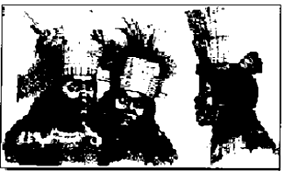
A CELEBRATION OF
DIVERSITY:
Retrospective
Of Oakland's History
by Paris Williams
Ten thousand years ago the first humans came the
the East Bay. They found the same mild weather and a
bountiful land and sea. The huge mammals had given way to
smaller animals and the forests were teeming with game.
Beaches teemed with mussels, clams and crabs; creeks were
seasonally visited by spawning salmon.
The people who came were from many
places. Some were related to the Algonquin of eastern
Canada, others to the Aztec of the Mexico Valley. Thus,
the diversity we are accustomed to now began over ten
thousand years ago.

The Huichum
tribe of the Ohlone Indians
by
Louis Choris, 1822
These
first inhabitants "engaged in hunting and fishing,
dressing of hides, made nets for fishing, pipes for
smoking wild tobacco and rafts from river rushes. Basket
weaving, among women, was developed to a high art. They
were fond of sports and gambling and made ornaments of
shells and feathers." No evidence has been found of
organized warfare.
The East Bay was first explored by a
Spanish expedition in 1769-70. In 1775 the De Anza
expedition arrived. Their party included a small boy who
would one day become Don Luis Peralta, the owner of
Oakland and most of the East Bay area.
In 1842, Don Luis divided his estate
between his four sons. His eldest, Antonio established
his rancho in what is now the Fruitvale District. Ignacio
was given land from San Leandro Creek to Seminary Avenue.
To Vincinte went all of the land north and west of Lake
Merritt to Alcatraz Avenue. Jose received the land that
is presently Berkeley, Albany, El Cerrito and part of
North Oakland.
Some Americans who came into this part
of Mexico bought or rented land from the Peraltas. Some
received land grants from the Mexican government. Others
simply settled on Mexican owned land and would later
claim ownership of what had indeed been stolen.
On May 13, 1846, the United States went
to war with Mexico over land disputes and the extension
of slavery into Texas. Rumor spread that the Mexican
government would soon restrict American immigration into
California. This resulted in the "Bear Flag
Revolt" and the eventual annexation of California by
the United States. Three months after annexation, gold
was found at Sutter's Mill.
In 1848 the first Chinese immigrants
arrived, two men and a woman. By 1852, over 20,000
entered through the Port of San Francisco. The first
Chinese in Oakland worked as loggers (in the hills) and
tenant farmers. These farmers, who were prohibited from
owning land, provided most of the fresh produce consumed
throughout the Bay Area. As Oakland began to grow, the
Chinese built the Chabot and Temescal Dams, worked in
jute mills and the explosives factory, labored on the
harbors, in railroad construction and developed the
shrimping industry.
By 1850, Oakland was home to a small
black community. "The first East Bay census, taken
in 1852, shows six black American men, one woman and
eight black men from other countries.
Slavery had been abolished by Mexico in
1829, soon after achieving independence from Spain. When
California was annexed to the United States, slavery once
again became a threat to African-Americans as well as
oppressive laws designed to prevent them from owning land
and defending their rights in court. Many were subjected
to the accusation of being runaway slaves and were
kidnapped into bondage with the assistance of the courts.
In 1857, Elizabeth Flood, wife of
pioneer Isaac Flood, opened a school for black children.
After the passage of the Fifteenth Amendment to the
Constitution in 1872, granting voting rights to black
men, the Oakland School Board voted 5 to 2 to admit
"children of African decent" into public
schools.
Mexicans, Chinese and African Americans
were not the only local representatives of diversity.
"Alameda County's population in 1870 was more than
65% foreign born. The largest group was Irish , who
formed the congregation of Saint Patrick's Church in West
Oakland. There were also a large number of Germans
running breweries and beer gardens in Fruitvale. Later,
Italians settled in the Temescal area. A community of
Jews formed in the neighborhood near the Synagogue at
13th and Clay street.
"Many Portuguese arrived and went
into dairy farming. The California Cotton Mills began by
importing skilled Scottish textile workers to train local
hands who formed a community near the mill. The English,
Welsh, Norwegians, Danish, Swedes, Finns and French were
also represented..
This was the beginning of our city.
This exhibit is an exploration of the history of Oakland
that draws its inspiration from a desire to understand
the present and to better envision the future. As we
approach the 21st Century our political, social, cultural
and commercial decisions will be increasingly influenced
by the process of forging a new notion of community. Will
this strain our creed to the breaking point or will it
expand the ideals of democracy?
By knowing how these questions have
been answered in the past we may gain insight into the
future. We may also find fragments of nature and
ourselves that may be recovered and celebrated and
shared.
A Biography of Paris Williams
An Oakland native, Paris Williams has always had
an interest in history. She received her degree in
Anthropology from Antioch College and is now pursuing a
master's degree at the University of California,
Berkeley. After conducting research and fieldwork in more
than a dozen countries she was commissioned by Festival
at the Lake 1990 to develop this exhibit on the history
of Oakland's natural and ethnic diversity. She also
worked on an oral history project on the California
Hotel and the development of the post-war African
American community in Oakland.
ë
|